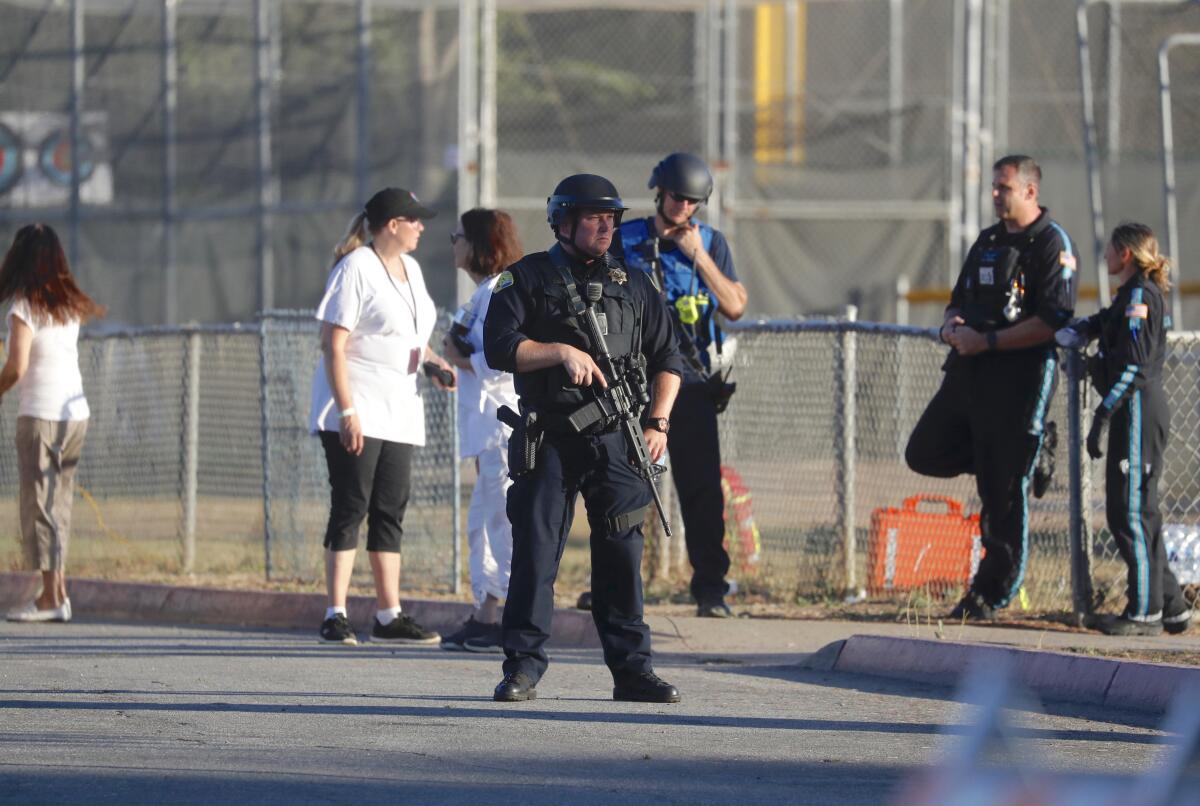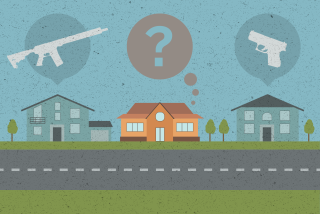California’s ‘red flag’ law might be helping to reduce mass shooting risk, study says

Four years after California became one of the first states to expedite the removal of guns from people seen as a public danger by family members or law enforcement, its “red flag” law appears to be helping to reduce the chance of mass shootings, according to a study released Monday by the UC Davis School of Medicine.
The initial findings by the school’s Violence Prevention Research Program were made public just hours after Gov. Gavin Newsom said Monday that he is interested in receiving a group of pending bills that would significantly expand the use of so-called “extreme risk protection” orders.
At the same time, recent mass shootings in Gilroy, Calif., as well as El Paso and Dayton, Ohio, have renewed the conversation in Congress about possibly adopting national red flag laws.
UC Davis researchers examined 21 cases of individuals who had firearms removed from them or purchases blocked because of court orders. The researchers found that none of the individuals was later involved in gun-related violence.
“We can’t prove that the orders are responsible for the outcome,” said Garen Wintemute, a professor of emergency medicine and the director of the Violence Prevention Research Program.
“But there is an obvious logic to this — that if somebody is posing an imminent threat whether it’s to others or to themselves, and firearms are a part of that threat, recovering the firearms can help reduce the threat,” Wintemute added.
The existing law, which took effect in 2016, resulted in judges ordering the temporary removal of firearms from more than 600 people after family members or law enforcement offices petitioned the courts saying the individuals appeared to pose a risk to harm themselves or others.
Of 414 cases through 2018, some 91% involved males and 61% were non-Hispanic whites, the study said. UC Davis researchers are continuing to collect information on orders issued, but the initial report focused on 21 cases where 52 guns were removed from individuals.
“Most subjects made explicit threats and owned firearms,” said the study, which is scheduled to be published in the next issue of the Annals of Internal Medicine.
In three cases, individuals had purchased guns but were undergoing the 10-day waiting period before delivery, and a court order blocked their acquiring of the firearms, said Wintemute. In one of those cases, a man was awaiting delivery of a shotgun, but officers who searched his home found 400 rounds of ammunition.
Some of the cases involved people whom mental health workers identified as at risk.
A check of social media and newspapers found that none of the 21 subjects of the orders had appeared to harm themselves or others, the researchers said.
“It is impossible to know whether violence would have occurred had [restraining orders] not been issued, and the authors make no claim of a causal relationship,” the study concluded. “Nonetheless, the cases suggest that this urgent, individualized intervention can play a role in efforts to prevent mass shootings, in health care settings and elsewhere. Further evaluation would be helpful.”
Advocates for gun owners, who have objected to the court orders for infringing on due process rights, said they doubted the value of the study given its limitations.
“There is no way for them to quantify what would have happened had they not issued” court orders, said Sam Paredes, the executive director of Gun Owners of California.
He noted that some men were recently arrested in other states after threatening mass shootings, and no court orders were needed. “Existing laws were sufficient,” Paredes said.
Wintemute said he has sent the study findings to members of Congress, including Republican Sen. Lindsey Graham of South Carolina, who chairs the Senate Judiciary Committee and has a bill that would provide grants to states to design and enforce red flag programs.
The cases profiled by the study include one in which a man threatened to kill employees of his family’s business. His mother alerted authorities and they confiscated 26 guns.
Another protection order was issued when a high school assistant principal alerted authorities about a 15-year-old student who spoke favorably of the Parkland, Fla., shooter and said “school shooters are gods.”
Others subjected to court orders threatened shootings at businesses, schools and religious institutions, including a mosque.
“Public mass shootings in Parkland, Florida; Aurora, Colorado; and Tucson, Arizona, among others, were committed by assailants known to family members, acquaintances, law enforcement agencies, and in some cases health professionals to be at a high risk for violence,” the study noted.
The current law allows guns to be removed for 21 days at first but can be extended to a year after a court hearing involving the targeted individual.
Assemblyman Phil Ting (D-San Francisco) has written one of nearly 10 bills pending that would enlarge California’s red flag law. His legislation would expand the number of people who can petition the court for orders to include co-workers, employers and school employees who believe individuals are a public risk of gun violence.
“It proves that strong gun control measures work,” Ting said Monday of the study. “You have potentially 21 people who could have carried out violent acts who aren’t able to because their guns were taken away.”
In previous years, then-Gov. Jerry Brown vetoed similar bills, saying employers and teachers can get court orders if they go through family members or law enforcement.
Wintemute said Ting’s bill has merit because some law enforcement agencies may be slow to respond to warnings from teachers, employers and others, and some family members may not be willing to put their name on a petition if there is a danger from the person being taken to court.
Other pending bills would increase the duration of court orders removing guns from one to five years, expand training of police officers in how to use the law, and permit gun owners to voluntarily surrender their firearms to a court. Newsom signaled Monday that he is open to the expansion of red flag laws, although he is waiting to see what reaches his office.
“I broadly support the intent of broadening these laws, though again the details of it we are all collectively working on,” Newsom told reporters in Sacramento on Monday. “But I am hopeful that that bill processes and comes down to my desk in a way that I can sign it.”
More to Read
Start your day right
Sign up for Essential California for news, features and recommendations from the L.A. Times and beyond in your inbox six days a week.
You may occasionally receive promotional content from the Los Angeles Times.







